
The Père David's deer, also known as the milu or elaphure, is a species of deer native to the subtropical river valleys of China. It grazes mainly on grass and aquatic plants. It is the only extant member of the genus Elaphurus. Some experts suggest demoting Elaphurus to a subgenus of Cervus. Based on genetic comparisons, Père David's deer is closely related to Eld's deer.

The sika deer, also known as the Northernspotted deer or the Japanese deer, is a species of deer native to much of East Asia and introduced to other parts of the world. Previously found from northern Vietnam in the south to the Russian Far East in the north, it is an uncommon species that has been extirpated in most areas of its native range, except in Japan, where it is overabundant and present in very large numbers.

Eld's deer, also known as the thamin or brow-antlered deer, is an endangered species of deer endemic to South and Southeast Asia.
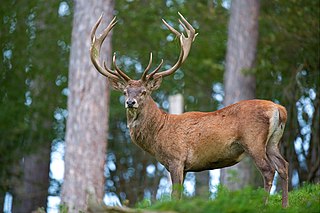
The red deer is one of the largest deer species. A male red deer is called a stag or hart, and a female is called a hind. The red deer inhabits most of Europe, the Caucasus Mountains region, Anatolia, Iran, and parts of western Asia. It also inhabits the Atlas Mountains of Northern Africa; being the only living species of deer to inhabit Africa. Red deer have been introduced to other areas, including Australia, New Zealand, the United States, Canada, Peru, Uruguay, Chile and Argentina. In many parts of the world, the meat (venison) from red deer is used as a food source.

The sambar is a large deer native to the Indian subcontinent, South China and Southeast Asia that is listed as a vulnerable species on the IUCN Red List since 2008. Populations have declined substantially due to severe hunting, local insurgency, and industrial exploitation of habitat.

The chital or cheetal, also known as the spotted deer, chital deer and axis deer, is a deer species native to the Indian subcontinent. It was first described and given a binomial name by German naturalist Johann Christian Polycarp Erxleben in 1777. A moderate-sized deer, male chital reach 90 cm (35 in) and females 70 cm (28 in) at the shoulder. While males weigh 70–90 kg (150–200 lb), females weigh around 40–60 kg (88–132 lb). It is sexually dimorphic; males are larger than females, and antlers are present only on males. The upper parts are golden to rufous, completely covered in white spots. The abdomen, rump, throat, insides of legs, ears, and tail are all white. The antlers, three-pronged, are nearly 1 m long.

The eastern elk is an extinct subspecies or distinct population of elk that inhabited the northern and eastern United States, and southern Canada. The last eastern elk was shot in Pennsylvania on September 1, 1877. The subspecies was declared extinct by the United States Fish and Wildlife Service in 1880. Another subspecies of elk, the Merriam's elk, also became extinct at roughly the same time.

Thorold's deer is a threatened species of deer found in grassland, shrubland, and forest at high altitudes in the eastern Tibetan Plateau. It is also known as the white-lipped deer for the white patches around its muzzle.

The barasingha, sometimes barasinghe, also known as the swamp deer, is a deer species distributed in the Indian subcontinent. Populations in northern and central India are fragmented, and two isolated populations occur in southwestern Nepal. It has been extirpated in Pakistan and Bangladesh, and its presence is uncertain in Bhutan.
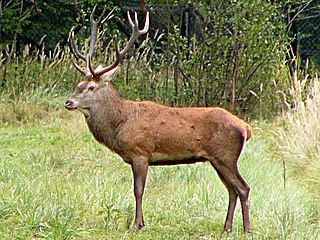
Cervus is a genus of deer that primarily are native to Eurasia, although one species occurs in northern Africa and another in North America. In addition to the species presently placed in this genus, it has included a whole range of other species now commonly placed in other genera. Additionally, the species-level taxonomy is in a state of flux.

The Kashmir stag, also called hangul, is a subspecies of Central Asian red deer endemic to Kashmir and surrounding areas. It is found in dense riverine forests in the high valleys and mountains of Jammu and Kashmir and northern Himachal Pradesh. In Kashmir, it is found primarily in the Dachigam National Park where it receives protection, and elsewhere it is more at risk. In the 1941s, the population was between 3000 and 5000 individuals, but since then habitat destruction, over-grazing by domestic livestock and poaching have reduced population dramatically. Earlier believed to be a subspecies of red deer, a number of mitochondrial DNA genetic studies later had the hangul as a part of the Asian clade of the elk. The IUCN and American Society of Mammalogists, however, include it in the new grouping of Central Asian red deer, with the Kashmir stag being the type subspecies. The 2008 census counted 160 mature individuals in the Kashmir valley and northern Chamba in Himachal Pradesh. According to the census in 2019, there were only 237 hanguls. According to 2023 census, the numbers have improved to 289.
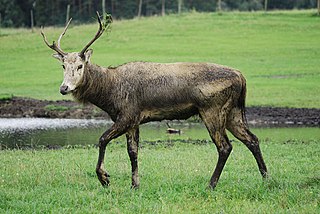
The Cervinae or the Old World deer, are a subfamily of deer. Alternatively, they are known as the plesiometacarpal deer, due to their ankle structure being different from the telemetacarpal deer of the Capreolinae.
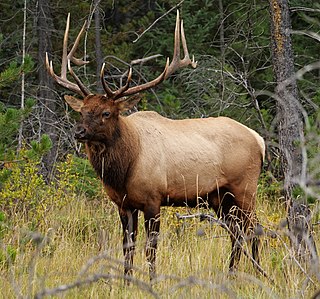
The elk, or wapiti, is one of the largest species within the deer family, Cervidae, and one of the largest terrestrial mammals in its native range of North America and Central and East Asia. The word "elk" originally referred to the European variety of the moose, Alces alces, but was transferred to Cervus canadensis by North American colonists. The name "wapiti" derives from a Shawnee and Cree word meaning "white rump" for the distinctive light fur in the rear region.
Reserved wild animals are the highest class of protection for animal species in Thailand's wildlife conservation framework. There are currently nineteen designated species, defined by The Wild Animal Conservation and Protection Act B.E. 2562 (2019). The 2019 act replaced the original law from 1992. The law prohibits hunting, breeding, possessing, or trading any of such species, except when done for scientific research with permission from the Permanent Secretary of National Park, Wildlife and Plant Conservation, or breeding and possession by authorised public zoos.
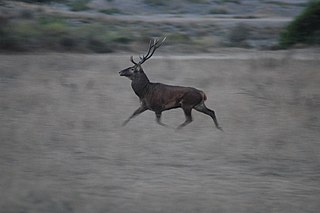
The Corsican red deer, also known simply as the Corsican deer or Sardinian deer, is a population of red deer found on the Mediterranean islands of Sardinia (Italy) and Corsica (France).
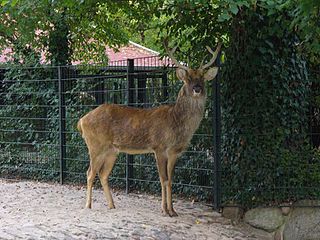
Rucervus is a genus of deer from India, Nepal, Indochina, and the Chinese island of Hainan. The only extant representatives, the barasingha or swamp deer and Eld's deer, are threatened by habitat loss and hunting; another species, Schomburgk’s deer, went extinct in 1938. Deer species found within the genus Rucervus are characterized by a specific antler structure, where the basal ramification is often supplemented with an additional small prong, and the middle tine is never present. The crown tines are inserted on the posterior side of the beam and may be bifurcated or fused into a small palmation.
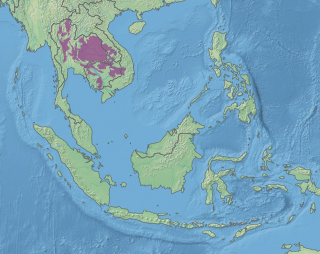
The Central Indochina dry forests are a large tropical and subtropical dry broadleaf forests ecoregion in Southeast Asia.

Rangsit is a city and neighbourhood in Pathum Thani Province, Thailand. Rangsit is a metropolitan city that supports the expansion of Bangkok in the north. Rangsit has become a departure point for travel to provinces in north, northeast, and eastern Thailand.




















